November 26, 2010
Air Date: November 26, 2010
FULL SHOW
SEGMENTS
Corn Ethanol Tax Credits
/ Jeff YoungView the page for this story
You might not think green groups, grocers, cattlemen and libertarians have much in common. But they’re working together against government support for corn ethanol: a six-billion dollar ethanol tax credit that will expire at year’s end unless Congress acts. Living on Earth’s Jeff Young reports. (05:50)
Carrotmobs and the Power of Buycotts
View the page for this story
From Montgomery, Alabama to South Africa, activists have learned that they can influence change by organizing where people shop. Now, conscious consumers are using a new tool to encourage business to go green. Instead of using the stick of boycotts, they are wielding the carrot of “buycotts.” Shoppers all over the world are organizing to mob businesses that make the largest pledge towards sustainable practices. Host Bruce Gellerman speaks with Brent Schulkin, founder of the group Carrotmob. (06:00)
Out of (a noble) Gas
/ Emily GuerinView the page for this story
The Federal Helium Reserve in Amarillo, Texas holds the world’s largest supply of useable helium. But that stockpile will be depleted within five years. Emily Guerin reports on the coming helium shortage. (05:40)
Navajo Nation Elections
View the page for this story
Ben Shelly is the President-Elect of the Navajo Nation. He talks with host Bruce Gellerman about the future of coal, renewable energy and tribal sovereignty in Navajo land. (06:00)
Audubon’s Birds of America
/ Laurie SandersView the page for this story
Audubon is a well-known name but, perhaps, the work of John James Audubon is not well-known. But his life-sized paintings of American birds have had a profound effect on the study of natural history. In the 1800’s, the collection of Audubon’s large portraits were made into a book called Audubon’s Birds of America. One of the complete original sets is housed at Amherst College in Massachusetts. Producer Laurie Sanders went to have a look. (06:10)
BirdNote® - The Day of the Turkey
View the page for this story
The Day of the Turkey: Woe to the turkey that finds its fate on the dinner table. This week’s BirdNote®, narrated by Michael Stein, looks back at the history of both the farmyard and wild turkey. (01:50)
The Eagle Soars
View the page for this story
At the age of five, J.C. High Eagle had a vision - he would someday help Americans travel to the moon. Against great odds, the Oklahoma Cherokee Indian's vision came true and J.C. High Eagle became an engineer for Apollo missions at NASA, the nation's space agency. Renowned storyteller Jay O'Callahan tells the story of J.C. High Eagle. It's part of Jay's larger work, commissioned by NASA for its 50th anniversary, called Forged in the Stars. (15:35)
Show Credits and Funders
Show Transcript
HOST: Bruce Gellerman
GUESTS: Brent Schulkin, Ben Shelly, Robert Richardson, Chip Groat, Jay O’Callahan (repeat from earlier show)
REPORTERS: Jeff Young, Emily Guerin, Laurie Sanders, Steve Curwood
NOTES: Michael Stein
GELLERMAN: From Public Radio International, this is Living on Earth. I’m Bruce Gellerman. Libertarians and green groups, grocers and ranchers form an unlikely alliance, finding a common enemy in corn ethanol.
MCMAHON: There’s something to be said when you can have Friends of the Earth and the Cato Institute both briefing Congress together in the same room and saying, ‘Yeah, corn ethanol subsidies need to go.’
GELLERMAN: Critics say our tax dollars are subsidizing ethanol exports to oil producing nations including Canada and Saudi Arabia. Also, we leaf through one of the biggest books ever printed – it’s a double elephant folio – but it’s strictly for the birds.
NELSON: One of the most popular Audubon Plates is The Wild Turkey in life size. It fills the entire leaf, pretty much within about a half of an inch to a quarter of an inch to the edge.
GELLERMAN: Big birds around turkey time. These stories and more - just ahead on Living on Earth. Stay with us.
[THEME]
Corn Ethanol Tax Credits

Some government support for ethanol could stop flowing as a tax credit expires. (Photo: Spencer Thomas)
GELLERMAN: From the Jennifer and Ted Stanley Studios in Somerville, Massachusetts, this is Living on Earth. I’m Bruce Gellerman. With its Turkey Day break over, Congress returns to the lame duck session with corn on the menu.
A multi-billion dollar tax break for corn-based ethanol will expire at the end of this year unless Congress acts to extend it. That’s brought together an unlikely alliance working to end government support for what they call a wasteful and environmentally harmful fuel. Living on Earth’s Jeff Young reports.
YOUNG: They say politics makes strange bedfellows. Consider the scene at one recent congressional briefing on corn ethanol subsidies. A pro-business think tank and an environmental group often at each other’s throats, found they had something in common.
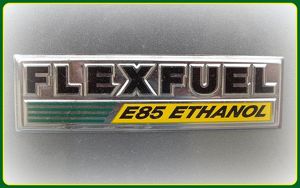
Ethanol advocates hope the government might break the so-called “blending wall” with more flex fuel vehicles.
MCMAHON: There’s something to be said when you can have Friends of the Earth and the Cato institute both briefing Congress together in the same room and saying, yeah, corn ethanol subsidies need to go.
YOUNG: Friends of the Earth ethanol campaign leader Kate McMahon says her group dislikes the polluted runoff from fertilizer and pesticides used to grow corn for ethanol. And she points to studies showing ethanol’s production generates more greenhouse gases than you’d get from burning gasoline.
MCMAHON: We have this idea in our heads that corn ethanol is good for the environment and good for climate but when you actually look at the numbers that’s just not the case.
GELLERMAN: The Cato Institute says ethanol subsidies distort markets. Associations for grocers and ranchers think ethanol pushes up corn prices, hurting their business. And anti-poverty groups say higher food prices hurt the world’s hungry.
All are working in some way to end ethanol’s so called blender’s tax credit, which gives 45 cents a gallon for fuel blended with ethanol. That adds up to about six billion dollars a year. The credit’s been around for decades, but Steve Ellis of the budget watchdog group Taxpayers for Common Sense, says he and other ethanol opponents have another powerful ally—a newly austere environment in Congress that makes finding offsets in the budget much harder.
ELLIS: Well, the deck is a little bit stacked against the corn lobby. The challenge is when they passed pay-as-you-go reforms, pay-go reforms, to spend more money on this tax credit they have to find offsets. And, offsets are hard to come by. So when it was perceived to be free by Congress (even though it cost us a lot of money) it went through. But now the fact that they have to pay the piper, there isn’t a lot of interest.
YOUNG: That has people like Tom Buis racing against time as the Congressional calendar ticks down. He’s head of growth energy, an ethanol industry lobbying group. Buis says congress should support the industry because it’s the only fuel alternative ready to reduce dependence on imported oil.
BUIS: Today’s ethanol production is ten percent, roughly ten percent of our entire gasoline usage in the United States, which is not insignificant at all. And, if you look at alternative fuels there are none. We’ve waited around on this far too long. It’s a national security, it’s an energy security, it’s a U.S. jobs security issue, and it’s an environmental issue.
YOUNG: But Buis’s argument about ethanol as a home-grown alternative to oil imports was undermined somewhat by news that the U.S. is now selling some ethanol abroad. Gregory Meyer at the Financial Times reported on a small but growing amount of U.S. ethanol exports.
MEYER: It is a bit of an odd turn of events that we are now exporting some of this ethanol everywhere from Canada to the Netherlands to the United Arab Emirates.
YOUNG: The exports aren’t much by volume, but it’s enough to anger European biofuels companies. They say the U.S. businesses benefit from the blenders tax credit then use a loophole in EU tariff law to send their subsidized product overseas. But Meyer says the underlying issue is that the U.S. has a glut of ethanol on market and policy that prevents greater domestic use.
MEYER: The US has kind of a biofuels policy that is at odds with itself. On the one hand, the law requires companies to blend 12 billion gallons of ethanol, but at the same time there’s a cap on how much ethanol you can blend into each gallon of gas.
YOUNG: In the ethanol industry this is known as the “blending wall.” There’s a law that says use the stuff. But EPA rules say only use ten percent, or E-10, in any given gallon. A higher mixture might damage older engines. The EPA is looking into whether E-15 fuel is ok for older vehicles. That decision’s expected early next year.

Some government support for ethanol could stop flowing as a tax credit expires. (Photo: Spencer Thomas)
Tom Buis at Growth Energy realizes his industry’s in a corn version of a catch-22. With the tax credit in trouble, he’s floated an idea for a different kind of government help to break down the blending wall. Support for flex fuel vehicles that can handle higher ethanol blends and service station pumps—called blender pumps-- that can deliver it.
BUIS: And a blender pump allows the consumer to choose the blend of ethanol that they want in with their fuel. The second part of it is the increased production of flex fuel vehicles in America, and that way a flex fuel vehicle can burn any blend that you want, from E 0 up to E 85. So you put power in the hands of the consumer.
YOUNG: Buis says this will reduce the industry’s reliance on tax credits and create more demand for ethanol made from cellulose from rather than corn. Cellulosic ethanol—made from wood chips, crop waste or grass—has a better environmental profile but it’s still too costly.
Ethanol opponents remain skeptical. But if the tax credit expires in December you can be sure the new Congress will get an earful about these ethanol ideas come January.
For Living on Earth, I’m Jeff Young.
[MUSIC: Steely Dan “Gaslighting Abbie” from Two Against Nature (Giant Records 2000).]
Related links:
- A sampling of some competing studies showing different results for the energy and greenhouse gas benefits of ethanol. Study 1.
- Study 2
- Study 3
- Study 4
- EPA on ethanol
- Growth Energy’s ethanol infrastructure proposal
Carrotmobs and the Power of Buycotts
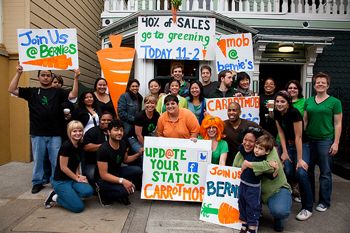
The Carrotmob buycott spread quickly to other San Francisco stores. (Photo: Carrotmob)
GELLERMAN: From subsidized ethanol to something completely different…It’s party time at Living on Earth.
[MUSIC: Jazzanova “Fedimes Flight (Kyoto Massive Remix) from Remixed (Sonar Kollectiv 2003).]
WOMAN: I’m completely blown away by the turnout.
MAN: I’ve been amazed at the number of people that are showing up.
GELLERMAN: Take out your glitter makeup, your acid washed denims, and don’t forget your wallet. This ain’t no disco, this ain’t no foolin’ around. This is a Carrotmob. Carrotmob is a way for environmental activists to capitalize on capitalism. Using the power of their purse to persuade businesses to go green. For example getting a liquor store to put in energy saving light bulbs.
In 2008 Carrotmob Founder, Brent Shulkin, biked to 23 stores in San Francisco and promised the owners more customers if they pledged to invest a portion of their proceeds towards energy efficiency. At the convenience store that pledged the highest, Brent made it rain money.
MAN: CFL’s and bourbon together at last. It’s about time, right? Somebody had to do it.
BRUCE: That somebody is Brent Schulkin. Founder of Carrotmob. Forget sticks and protests to get companies to do the environmentally right thing, Shulkin says, why not reward businesses with a Carrotmob.
SCHULKIN: A couple years ago I was in San Francisco, and I got on my bike and rode around to 23 different convenience stores. And, at every store, I went in and I said, ‘what I’m going to do is I’m going to bring hundreds of people to one store on one day and we’re just going to spend a ton of money.’ And so what I asked was what percentage of this revenue we would bring will you set aside and reinvest in energy efficiency upgrades to your store?
Finally, one store said, ‘I’ll give you 22 percent of everything you guys would spend.’
So then I turned around and went to the community, put up some fliers and spread the word on the internet and said ‘everyone come down.’ And then on the day of the Carrotmob, hundreds of people showed up at this convenience store, there was a line around the block. When it was all over- their typical daily revenue is maybe 18 hundred dollars, a little more than that one the weekend- we brought in 92 hundred dollars in just a couple hours.
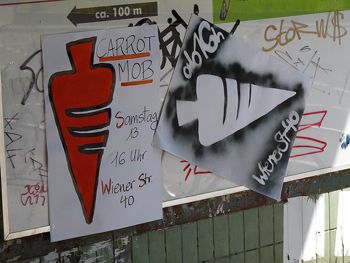
German consumers have been especially receptive to Carrotmobbing. (Photo: Carrotmob)
And, in exchange, they took a big chunk of that money and did a full lighting retrofit of their store to be more energy efficient.
GELLERMAN: So, who organizes a Carrotmob?
SCHULKIN: Well, what happened after that first was this video spread like crazy. And we just started getting emails from people around the world who said, ‘hey, I saw what you did in San Francisco, can we do it, will you support us?’
So now we’ve grown to a global network of people and we’ve seen organizers in Helsinki who’ve organized a mob of a nightclub, Bubble Tea stand in Singapore, in Thailand we’ve seen a school that banned plastic bags at a grocery store, and all across the U.S. The biggest countries are actually Germany and Finland. They are just nuts for Carrotmob.
GELLERMAN: I guess you call it, not a boycott, but a buycott.
SCHULKIN: Yeah, I mean, Carrotmob is basically the opposite of a boycott. You know, in a boycott, you say, ‘alright, we’re not going to spend any money at this business until you change.’ But a Carrotmob you say, ‘we’re going to ask all of you businesses to compete to say who is willing to do the most socially responsible thing, whatever we ask.
And, whoever wins, we’re all going to come and spend money- we’re going to mob you with spending.’
GELLERMAN: How do you ensure that the company or the business that says that it’s going to do something socially beneficial actually does something.
SCHULKIN: I used to worry about that. I thought it was sort of the Achilles heel of this movement. I don’t anymore. And, the reason is that almost all of these businesses are in it- some are in it for the cash- but a lot of them are in it for the reputation, the long-term value of being seen as this great business in the community.
And, if you’re in it for the reputation, you know how harmful it would be if you then said, ‘haha, just kidding, we didn’t follow through, suckers!’ We just haven’t had any problems, and we’ve now had 112 or so campaigns and there’s never been a problem with it. So, I don’t worry about it anymore.
GELLERMAN: So, you’ve had over a hundred Carrotmob campaigns, any quantification of the results?
SCHULKIN: Well, yeah, most of the campaigns so far have been focused on energy efficiency. The best estimate that we have is that I think we’ve saved around 18 million kilowatt hours of electricity. But, this is not our own, exact data, this is just some projections that we have, so, as we raise money we’re going to be building out some better tools for measuring our impact.
GELLERMAN: Does this work principally with small stores, or could you use it for big box stores as well?
SCHULKIN: Ah! Well, you’re barking up the right tree! So, we want to make an enormous network of people. I’m not going to be satisfied with a million people, I want, you know, five, ten, twenty, fifty million people.
The reason is, if you can get that many million people in this network, you could do Coke vs. Pepsi, Nike vs. Reebok, you could start retrofitting and changing policies at some of the world’s most powerful companies.
GELLERMAN: Actually I could see this being a lot of fun, you have these mobs swarming to a store and turning into, really, kind of a pleasant community activity.

The Carrotmob buycott spread quickly to other San Francisco stores. (Photo: Carrotmob)
SCHULKIN: Yeah, and you know, one other sort of fun idea that I have been mulling is- imagine SuperBowl 2014 comes along and all across America we’re having these big SuperBowl parties as Americans do, and what if we said- we’re all going to buy either Miller Light, Coors Light or Bud Light for our SuperBowl parties- which is going to be a whole lot of beer. Which of those companies is willing to have a wind-powered brewery?
Or you know, maybe it’s a new maternity leave policy- we could ask for anything. That’s the type of campaign- how fun would that be? Who wouldn’t join in on that sort of campaign? And that’s, you know, I think there’s such a broad appeal to this movement, it’s so easy to get involved that I hope that we can have everyone join the network and we can grow the network to the point where those things are possible.
GELLERMAN: Well, Brett, thank you very much. It’s fascinating!
SCHULKIN: Well thanks Bruce, I’m glad I was able to spread the word a little bit!
GELLERMAN: Brent Schulkin is founder of Carrotmob. To find out more visit our website, L-O-E dot org.
[MUSIC: Jazzanova “Fedimes Flight (Kyoto Massive Remix) from Remixed (Sonar Kollectiv 2003).]
Related link:
Want to know more about Carrotmobbing your town?
GELLERMAN: Just ahead, the Navajo nation turns from Mother Earth to Father Sky in search of energy. Keep listening to Living on Earth!
[CUTAWAY MUSIC: Jimi Hendrix: “Castles Made Of Sand” from West Coast Seattle Boy: The Jimi Hendrix Anthology (Sony Music 2010)]
Out of (a noble) Gas
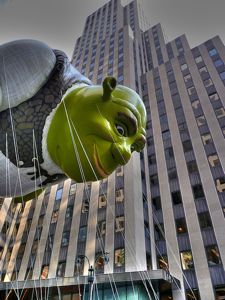
Big balloons like this one at the Macy’s Thanksgiving Day parade are only a small fraction of the total world consumption of helium. (Photo: Flikr/Joiseyshowaa)
GELLERMAN: Helium is a noble gas – and much more than the stuff that sends SpongeBob skyward at the Macy’s Thanksgiving Day Parade. It also keeps MRI magnets cool and cleans rocket engines. Helium is also very common; after hydrogen, it’s the second-most abundant element in the universe. Here on earth though, supplies are running low. Living on Earth’s Emily Guerin has the story.
[SOUND OF BALLOON BEING INFLATED, SQUEAKS.]
RICHARDS: (Inhales). Hi (in a chipmunk voice).
GUERIN: Ooh, that’s really good.
RICHARDS: (In a chipmunk voice) See, you gotta suck down.
GUERIN: Employee Amy Richards and I are the only ones in the Party Plus store in Biddeford, Maine. We’re taking turns sucking on helium from yellow balloons.
RICHARDS: YUP!
[LAUGHTER, BALLOON DEFLATES.]
GUERIN: That’s awesome!… I offer to pay Amy for them, but she says not to worry about it. Helium is cheap, a Party Plus balloon only costs 90 cents. And that, says Nobel Prize-winning Cornell physicist Robert Richardson, is the problem.
RICHARDSON: The birthday party consumption of helium is probably only five percent, but it’s more symptomatic of the waste.
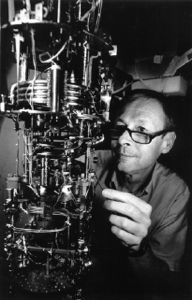
Nobel laureate Dr. Robert Richardson at his Cornell physics lab in 1989, inspecting a low-temperature apparatus, which uses helium to reach temperatures close to absolute zero. (Photo: Cornell University Photography)
GUERIN: Helium has always been so cheap that it doesn’t make economic sense to recycle it. Reseachers let the gas escape after using it in their low-temperature physics experiments. After the Thanksgiving Day Parade, the huge balloons are just deflated. And after using the gas to clean rocket engines…
RICHARDSON: NASA vents the helium into the atmosphere. And that’s a form of squandering.
GUERIN: Dr. Richardson says up until now, that waste hasn’t been a problem. There’s always been enough helium to go around. But that’s no longer the case. In fact, the world supply of readily available helium is running out.
GROAT: Helium comes from the decay of radioactive material in the crust of the earth and it’s very light of course so it escapes.
GUERIN: Dr. Chip Groat, a geoscience professor at the University of Texas-Austin.
GROAT: In some cases it gets trapped up in natural gas, methane, and it accumulates with that methane when it accumulates.
GUERIN: One of the most helium-rich natural gas deposits in the world lies beneath the southern Great Plains. And there, just outside Amarillo, Texas, is the federal helium reserve-- an underground helium storage area managed by the U.S. government. The reserve was created back in the 1920s, when helium-filled airships looked like one of the military vehicles of the future. But then came the Hindenburg disaster…
[NEWS CLIP OF THE HINDENBURG DISASTER: “OH THE HUMANITY!!”]

The Crude Helium Enrichment Unit at the Federal Helium Reserve in Texas. (Photo: The Bureau of Land Management)
GUERIN: The Hindenburg exploded because it was full of flammable hydrogen, not helium. Still, after the disaster, airships, whatever they were filled with, fell out of favor. But Dr. Groat says helium found a new niche.
GROAT: The use of it in welding, the development of MRIs required helium. And then a lot of pretty important low-temperature physics research that was of strategic importance to the United States also uses a lot of helium. So the feeling was still that we needed a reserve of helium, but for different purposes.
GUERIN: But according to Dr. Richardson, by the 1990s, the feds saw things differently.
RICHARDSON: The argument was that the Cold War was finished, and the federal government had no business competing with private industry.
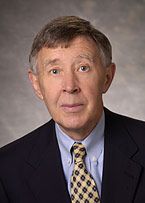
Dr. Charles Groat is the John A. and Katherine G. Jackson Chair in Energy and Mineral Resources, Department of Geological Sciences and Professor of Geological Sciences and Public Affairs at the University of Texas-Austin. (Photo: Charles Groat)
GUERIN: Also, the helium program had cost the taxpayer one point four billion dollars. The government wanted that money back. So in 1996 Congress passed the Helium Privatization Act, which planned to sell off all the helium in the reserve by 2015. In the meantime, the world changed. China and other industrializing countries in Asia started gobbling up helium, demanding more and more to produce LCD screens and fiber optics. And suddenly, scientists in the U.S. started having a hard time getting a hold of helium. Again, Dr. Groat.
GROAT: Frankly the group that became the most alarmed was the research community that uses helium and found it couldn’t afford it anymore, and in some places it couldn’t even get it anymore because it was being competed for by commercial people who could pay more money.
GUERIN: Even though helium is the second most abundant element in the universe, it’s expensive to strip it out of natural gas deposits. Other countries have helium.
RICHARDSON: Russia. Or Qatar. Or Algeria.
GUERIN: But Dr. Richarson says they’re not refining it yet. He thinks they’re holding out for economic reasons.
RICHARDSON: They are anxious for the United States to run out of helium because the price of helium will just sky rocket.
GUERIN: So the world isn’t running out of helium. But by selling off the federal helium reserve, the US runs the risk of depending on unknown or unfriendly sources for this essential element, says Dr. Groat.

Big balloons like this one at the Macy’s Thanksgiving Day parade are only a small fraction of the total world consumption of helium. (Photo: Flikr/Joiseyshowaa)
GROAT: Getting information about market prices and supplies in other parts of the world has been extremely difficult. I would be very surprised if we’re running out, I think we just haven’t found and developed the resources that are out there.
GUERIN: In the meantime, there are some substitutes for helium. Argon can be used for welding. And there are ways to recycle helium instead of just venting it into the atmosphere, and that could be come more popular after the U.S. reserve runs out. But until other countries start producing, everything that uses helium--MRIs, TV screens, even balloons--will likely become more expensive. So talk like one of the chipmunks while it’s still cheap.
[INHALES AIR FROM A BALLOON]
GUERIN: (In a chipmunk voice): For Living on Earth, this is Emily Guerin.
[MUSIC: Jimi Hendrix “New Rising Sun” from West Coast Seattle Boy: the Jimi Hendrix Anthology (Sony Music 2010).]
Related link:
Read the full report of the Committee on Understanding the Impact of Selling the Helium Reserve.
Navajo Nation Elections
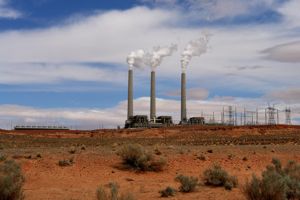
Emissions from the coal-fired Navajo Generating Station are responsible for haze over the Grand Canyon. The plant is the eighth dirtiest in the country, releasing 20.1 million tons of carbon each year. (Photos: Alex E. Proimos/Flikr)
GELLERMAN: It’s Living on Earth, I’m Bruce Gellerman.
[CODY SINGING TO TUNE OF GOD BLESS AMERICA]
GELLERMAN: The tune may sound familiar…but the words may sound strange.
[CODY SINGING]
GELLERMAN: This is Radmilla Cody singing “God Bless America…” in her native language--Navajo.
[CODY SINGING]
GELLERMAN: The Navajo Nation is the largest tribe in the United States in terms of geography and population. And on November 2nd, Navajos voted for their president. The winner was Ben Shelly, the current Vice President. Here’s a clip of Shelly during a presidential debate.
SHELLY: We want your help to build this nation, to be competitive in the world. We’re a sovereign government for Christ’s sake, why can’t we do things for ourselves and be who we are supposed to be: a great Navajo Nation.
GELLERMAN: The Navajo Nation President-elect Ben Shelly will lead is resource rich, and dirt poor. Half the population is unemployed. Navajoland is huge, spreading out over four states where Arizona, Utah, New Mexico and Colorado meet. It sits on vast reserves of coal. Unfortunately, the coal is buried deep under the high desert. But Shelly says coal is where the future of the Navajo Nation lies.
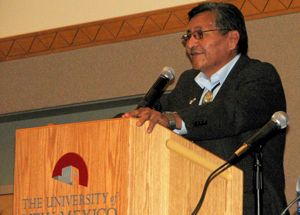
President-Elect Ben Shelly at a debate in Albuquerque. (Photo: Colleen Keane)
SHELLY: Coal is our major resource right now and 200, 200 years of coal that we have, and so it’s- we’re not going to do away with the coal, I’m sure we can use it. We’re working with the environmentalists, within the law we can use that coal safely. And then also make money and create jobs.
GELLERMAN: I mean, your coal expensive even relative to Wyoming where they just scoop it out in open mines. Yours is pretty expensive.
SHELLY: Yeah, it is (laughs). But, that’s what we have, we have to deal with it. Just cause it’s expensive doesn’t mean we’re not going to use it. We’re going to use it for our benefit. We also need to realize that we also have to deal with the environment and how to use that safely. So that we get support from all of the greenhouse people, environmentalists and all that so, you don’t want to fight them. So we always say take care of Mother Earth, and that’s what we do.
GELLERMAN: Coal provides the Navajo with a third of the tribe’s income and hundreds of jobs. But these days it’s becoming increasingly difficult for the Navajo to dig their coal and burn it in power plants located on their Reservation.
The U.S. Environmental Protection Agency and federal courts have been restricting the mining and use of Navajo coal. One of the coal-fired power plants on the reservation is among the most polluting in the country, sending smog over the Grand Canyon. So now, President-Elect Ben Shelly says the Navajo are looking towards Father Sky.
SHELLY: We can put a solar panel anywhere on the reservation, it’s prime area. This is a God-given country that God gave us and we can use that sun and make money off of it and make electricity. You know, coal will go away, and it gets, you know, mined out and it’s gone, but sun will always be there until God decides the world should end, so that’s going to be forever.
GELLERMAN: Can we place coal with solar?
SHELLY: Yeah, I don’t know how large it is going to be, we’re pioneering renewable energy. It’s there but how much energy can it create? Is renewable energy enough to supply the whole world? So, I still think that we’re still going to need some sort of a power plant to meet that kind of the demand of the population on energy.
And, the other thing that we’re thinking about- building as much renewable energy as we can, and also manufacturing all those parts ourselves, and also selling renewable energy to states. As you know, there’s 15 percent now that’s being called out to every states, that’s a mandate, that they have to use some form of alternative energy. And, some states don’t have these alterative energy, that’s where we will sell our energy to.
GELLERMAN: Despite Shelly’s optimism, renewable energy on the reservation is still pie in the sky. Coal sustains the nation, but even within the tribe, its continued use is controversial.
[WOMAN AT PROTEST: OSM, you can’t hide, we’ll charge you with genocide!]
GELLERMAN: In 2008, Navajo demonstrators gathered in Denver, protesting the re-opening of the Black Mesa coal mine.
[WOMAN AT PROTEST: We, Navajo and SOMETHING tribal members, have come to Denver to meet with the Western Regional Office of Surface Mining… ]

Emissions from the coal-fired Navajo Generating Station are responsible for haze over the Grand Canyon. The plant is the eighth dirtiest in the country, releasing 20.1 million tons of carbon each year. (Photos: Alex E. Proimos/Flikr)
GELLERMAN: Protesters prevailed; Black Mesa was shut down. And a federal judge would later prevent another coal mine from expanding, ruling that it would harm an ancient tribal burial site. But Navajo President-elect Ben Shelly says the decision cost the tribe 400 jobs. And the federal government should keep its laws off Navajo land.
SHELLY: Well I know that the federal law does cover us in certain areas. This is the first time that I’ve ever heard a federal judge dealing with coal, and they’re talking about sacred sites. You know, as you know, we have sacred sights- like San Francisco Peak. Where’s that judge at? I’d like to see him come in and have him help us out over there because we’ve been crying about sacred sites that were there, and what did they do? The approved it for a ski resort.
So, tell me what, tell me what’s going on here? The Indian tribes like the Navajo Nation are educated enough to run their own nation, and I still think that there are some people out there trying to keep us tied down so that you, you as a taxpayer- you, I think you’re getting a little tired of feeding us, you know? So, I thank all the taxpayers for supporting us this long, and let us run our own nation and let us run our own resources and help us along as we go along. Yeah, I’m getting a little bit emotional here- the Navajo Nation is ready to go on its own.
GELLERMAN: That’s Ben Shelly. He takes office as the next President of the Navajo Nation in early January.
[MUSIC: Peter Kater/Carlos Nakai “Navajo Land Blessing” from How The West Was Won (Silver Wave records 1992).]
Audubon’s Birds of America
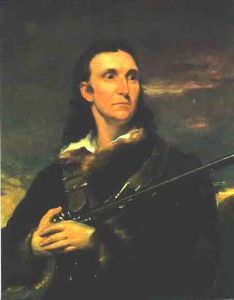
John James Audubon in The Naturalist as Frontiersman, painted by John Syme in 1826. (Photo: Irvin Department of Rare Books and Special Collections, Hollings Special Collections Library, University of South Carolina.)
GELLERMAN: John James Audubon’s book – “Birds of America” -- had a transforming effect on the study of natural history in the United States. The life-size images of the birds are colorful, artistic, and beautifully detailed. One hundred seventy five copies were originally printed but today just 120 of them have survived intact. Naturalist Laurie Sanders found one of them in Massachusetts at Amherst College.
[KEYS JINGLING]

Red-winged blackbird, illustrated by John James Audubon. (Photo: Image courtesy of the National Audubon Society)
SANDERS: Every Monday morning, in the lobby of the Special Collections department in Amherst College’s main library, Marion Walker undoes one lock, then another. She removes the back plate of glass from the display case that she and others in Archives call “the bird cage.” With a gentle pull, she slides out a large tray.
WALKER: This is one of the volumes of “Birds of America” by Audubon. It was given by the Pratt family, and we keep one volume out for a certain amount of time, and once a week we turn a page.
SANDERS: The book measures nearly two feet by three feet, and is one of the largest books every printed. Walker leans way over, gently, but firmly grips the page in two places, and slowly flips it over.
WALKER: And the paper’s rather-- not completely fragile, but we do want to be careful with it.
[SOUND OF PAGE FLIPPING]
WALKER: And there we have the prairie starling.
SANDERS: Today we know this specimen by a different common name—red winged blackbird. On this plate, Audubon has painted the male and female perched on a shrub, the male with his wings arched to show off his red shoulder patches, the female watching him. The image is one of 435 different birds that Audubon painted for “Birds of America.” Each bird is shown in life size, so relative to the size of the paper, these red winged blackbirds look small.
WALKER: We do have people who come here every week to see which bird is on display that week. So we have our regulars.
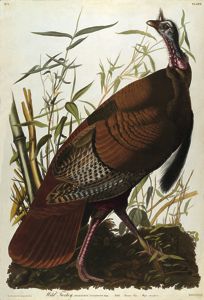
A Wild Turkey by John James Audubon. (Photo: The National Audubon Society)
SANDERS: But anyone can come here and ask to see all of the Audubon books.
[KEYS OPENING VAULT]
SANDERS: The other volumes are stored in a locked vault. They’re so heavy and awkward, that Archivist Peter Nelson says it takes 2 people to move them onto a cart and roll them to the reference room to look at.
NELSON: Most of the Audubon “Birds of America” are just the plates, and no letterpress printing. But our copy is the only known copy to have the list of subscribers’ names after the title page, and here we see the subscribers names, about 130 or so of them-- at the very top, his most gracious majesty George the Fourth, King of England.
SANDERS: Audubon came to the United States from France in the early 1800s as a young man, sent by his father to avoid being drafted into the Napoleonic Wars. He was a self-taught artist and naturalist. Once here, his first job was to oversee a lead mine on some family property near Philadephia.
But Audubon wasn’t very interested in doing that, and he wasn’t very good at it either. In fact, all of his attempts at later businesses failed too. The main reason is because he was much more interested in being outdoors, exploring, observing and painting wildlife-- especially birds. In 1819 he decided to devote himself entirely to painting and describing all the birds of America.
NELSON: Are you ready for this?
SANDERS: I’m ready.
NELSON: Okay. This is the biggie. (Turns page). Plate 1. One of the most popular Audubon Plates is the Wild Turkey in life size. It fills the entire leaf, pretty much within about a half of an inch or a quarter of an inch to the edge. Audubon painted his birds as naturalistically as possible. This was a very big departure from previous naturalists’ illustrations of birds and animals.
BURK: The worst thing that could happen to a bird was to see Audubon comes towards it, with a shotgun, basically.
SANDERS: John Burk is an Audubon scholar and professor of botany at Smith College.
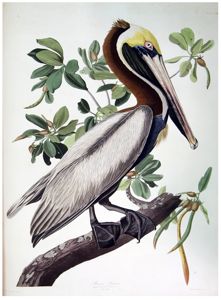
The Brown Pelican by John James Audubon. (Photo: Archives & Special Collections, Amherst College)
BURK: He would obviously kill them or buy them dead. Essentially he would wire them up in poses and then paint them. And he had a grid so that he could transfer the body onto the paper life-size.
SANDERS: Although the poses Audubon used were sometimes criticized as overly theatrical—or even inaccurate—Burk says Audubon’s “Birds of America” was hugely important.
BURK: First the illustrations made every bird widely available. Secondly there was a text, and it is not as wide read as it should be. It has sort of a rambling tone to it, and people have objected to various aspects of it. But, he described every bird that he knew, and gave a great deal of information that is certainly good today.
SANDERS: In the process of preparing “Birds of America”, Audubon discovered new species of birds. He painted several that are now extinct— Carolina parakeet, passenger pigeon, the Great Auk, the Heath Hen.
He was an avid hunter, but he also recognized that the certain species were declining because of over-hunting and habitat changes. Burk says, as a person, Audubon was driven, adventurous, lively and outspoken. He was a storyteller, who sometimes didn’t let the truth get in the way of telling a good story. Burk says if you read his memoirs, you either become angered, or intrigued. For Burk, it’s the latter.
BURK: You can look at the “Birds of America” with pleasure, again and again. I mean just leafing through I’m surprised how appealing they are and the drama that’s inherent in many of the pictures.
SANDERS: Unlike modern field guides where the birds are grouped together according to their similarities, Audubon organized Birds of America with a repeating pattern: a big bird, then a medium-sized bird, and then three smaller ones. Given its layout, Marion Walker never knows week to week which species to expect. She says she could look it up in the index, but the surprise is part of the delight of her Monday morning ritual. Still, she doesn’t resist when I ask her to look ahead.
WALKER: [gasps] Oooh! Oh my goodness. It’s the pelican. It’s the brown pelican.
SANDERS: For Living on Earth, I’m Laurie Sanders.
[MUSIC: Jimi Hendrix “New Rising Sun” from West Coast Seattle Boy: the Jimi Hendrix Anthology (Sony Music 2010).]
GELLERMAN: Coming up – a young Native American looks to the stars and helps land a man on the moon. That’s just ahead on Living on Earth.
Related links:
- Amherst College Archives and Special Collections
- Audubon’s Birds of America
BirdNote® - The Day of the Turkey
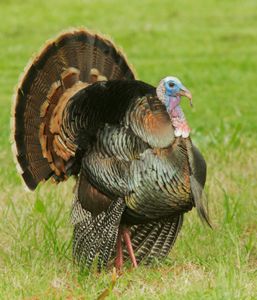
The bright colors of the male Wild Turkey. (Photo: Tom Grey©)
GELLERMAN: Coming up – a young Native American looks to the stars and helps land a man on the moon. That’s just ahead on Living on Earth.
GELLERMAN: It’s Living on Earth, I’m Bruce Gellerman.

A female Wild Turkey. (Photo: Tom Grey©)
[BIRD NOTE THEME]
GELLERMAN: In honor of the nation's favorite feast, we savor the turkey in this week's BirdNote© narrated by Michael Stein.
[TURKEYS GOBBLING]
STEIN: Any farmyard turkey still gobbling on the day after Thanksgiving is a fortunate bird. If that same turkey survives past Christmas dinner, it is a truly lucky fowl.
[TURKEYS GOBBLING]
STEIN: Farmyard turkeys were domesticated from a species called the Wild Turkey, originally native to the eastern and southwestern states and parts of Mexico. Wild Turkey numbers had plummeted by the early 20th Century, due to over-hunting and loss of habitat.
Yet fortune would smile on the Wild Turkey too. Game managers stepped in, re-introducing wild-caught birds to areas where turkeys had become scarce.
From the 1940s onward, there has been an upward trend in Wild Turkey numbers. In fact, turkeys now run wild in all of the lower 48 states and Hawaii, well beyond their original range.
[TURKEYS GOBBLING]
STEIN: But, back to the farmyard turkey. It is likely that the Mayans of southern Mexico had already domesticated turkeys as long as 2000 years ago.
Early Spanish explorers in the New World sailed off with domestic turkeys from Mexico, and soon turkeys were gobbling in farmyards over much of the world.
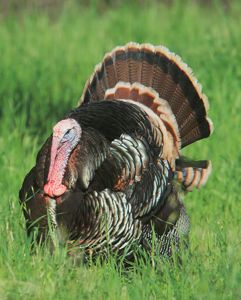
Will this turkey avoid the dinner plate this year? (Photo: Tom Grey©)
Early European colonists to America’s Atlantic seaboard actually brought domestic turkeys with them, completing the circle back to the New World.
It’s been a long and curious ride for the turkey, showing us both the upside — and downside — of life as a dinner table delicacy.
[TURKEYS GOBBLING]
GELLERMAN: That’s Michael Stein of BirdNote©. To see photos of wild turkeys, scratch a path to our website L-O-E dot org.
Related links:
- Call of the Wild Turkey provided by The Macaulay Library of Natural Sounds at the Cornell Lab of Ornithology, Ithaca, New York. Recorded by G.A. Keller
- Gobble of the domestic turkey provided by Martyn Stewart, Naturesound.org
- BirdNote® “The Day of the Turkey” was written by Frances Wood and updated by Bob Sundstrom.
The Eagle Soars
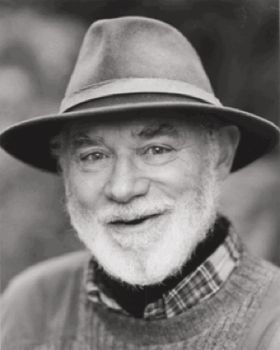
Jay O'Callahan (Beverly Hall Photography)
[MAN AT APOLLO 11 LIFT-OFF: Three, two, one, zero—all engines running—lift off! We have a lift off!]
GELLERMAN: When NASA, the National Aeronautics and Space Administration, was preparing to celebrate its 50th anniversary, it handed storyteller Jay O’Callahan a mission: write a love letter to the space agency. Well, it took 18 months, 30 books, 40 interviews, a course in Astronomy, and a thousand pages of emails and transcripts. The result is perhaps the most researched love letter ever written. Jay O’Callahan calls it “Forged in the Stars.” He told that story last year on Living on Earth – and by popular listener demand here it is again: Jay O’Callahan with our own Steve Curwood.
CURWOOD: So, what got you interested in space exploration to begin with?
O’CALLAHAN: I’ve grown up with it as much of my generation, but I’ve also lost a deep interest like much of my generation and when I got the commission and began to take this course in Astronomy so I can see…I can see Saturn. I talked to a professor at Harvard, he said, ‘I’m so excited we can see the rings of Saturn as clearly as the grooves in a record!’ It kind of let me expand and realize, we as a human race are expanding. And we haven’t caught up with it. I’m so intrigued that when Armstrong and Aldrin went around the Earth after landing on the moon, people would run up and they’d never say ‘you did it’- ‘We did it! We did it!’ This sense of this is humanity’s achievement, and perhaps it can help pull us together.
CURWOOD: You get the commission. How do you go about doing the research for this story?
O’CALLAHAN: NASA was very helpful. My boss Ed Hockman we went down to Huston together and interviews were set up- a lot of interviews with very different people, people responsible for food, people responsible for the chairs the astronauts sit in, for engineering…so a lot of interviews. And then we’re going off to jet propulsion laboratory, and I thought, “This is going to be boring. These people are responsible for robots, un-manned space.” They were fascinating! They were passionate. It was one of things that struck me. These people were passionate. Almost every person said ‘I love working here. I’m so lucky to have this job, I dreamed about this as a kid.’ So, that passion I think helped me become passionate about their work and wanting to tell their story.
CURWOOD: Well I understand that you’re now going to perform an excerpt from “Forged in the Stars” for us, what are we going to hear?
O’CALLAHAN: You’re going to hear about a young man who had a vision. And, I love that he had a vision, because, for thousands of years there’s been this vision of… ‘maybe we could go there, maybe we could go to the moon, maybe beyond.’ And, this is a five year old boy and he has a vision, and you’ll see in the story he’s encouraged. He’s not written off, go out and play- he’s listened to- and he pursues the vision.
[MUSIC: Llewellyn “Peace” from Reiki (New World Music 1999)]
O’CALLAHAN: In 1948, in a working-class neighborhood in Oklahoma City, a five-year-old boy ran into the kitchen, he said, ‘Mom, I heard a voice.’
‘A voice?’
‘Yes, it was coming from way up by the sun, it said I was going to have something to do with getting people to the Moon!’
And she said, ‘That’s a vision.’ And she said that because they were Cherokee, Osage. She said, ‘You’re going to have to work for the vision.’ Working meant being good at mathematics and physics.
His name was J. C. High Eagle-- that was his Cherokee name. His name in the white world was Jerry Elliot. He did well in high school.
Then, J.C. High Eagle, 1961, went to the University of Oklahoma, 18, excited – physics, mathematics! And, he found a lot of students didn’t want him there.
‘What’s the Indian kid doin’ here?’
A lot of professors didn’t want him.
‘You’re a fine young man, but see nature hands out gifts indiscriminately, and your people don’t have, well, the mental wherewithal to be engineers, scientists. You’re wasting your time.’
He was hurt, but he had the vision and he stayed with it. He did very well. In 1966, J.C. High Eagle decided to go to graduate school – physics, mathematics! But, there was no money. Stepfather had died, his mother was working.
So, this young man, J.C. High Eagle went down – this is Norman, Oklahoma – to the police station. ‘I want to be a policeman.’ They gave him a test. He scored as high as anyone has ever scored. He became a full-time policeman and a deputy sheriff. That meant he could take two courses a semester. Nine o’clock, ten o’clock was Electrical Engineering. He wore his uniform with a loaded gun to class. But, it was Oklahoma.
One day, his mother called and said, ‘There’s a telegram.’
‘Open it, Mom.’
‘It’s from the army – you have to report for your draft physical.’ He passed. She called again.
‘Another telegram for you.’
‘Open it.’
‘You’ve got to report to boot camp in 15 days –Vietnam. Ca—call your grandfather.’ J.C. called his grandfather – wise old man. Called him at his wheat farm.
‘Granddad, J.C. I’m going to boot camp in 15 days.’
‘They won’t take you.’
‘Oh, no. I got the piece of paper.’
‘I don’t believe in paper. They won’t take you. Had a hard time getting the calf born last night. [Laughs] I had to hitch the tractor up!’
‘Granddad, I’m going to boot camp.’
‘They won’t take you. Let me tell you about last night! [Laughs]’ His granddad went on and on, J.C. was furious. Hung up, called his mom: ‘He didn’t listen to me, said they wouldn’t take me. Went on and on about a calf.’
‘He’s my – my father. I’m with him.’ J.C. was furious; the two people he trusted didn’t listen to him! 15 days, 14, 13,12, 11, 10. On the tenth day, there was an angry drunk. He got a backpack, they arrested the drunk, and the drunk said to J.C. High Eagle, ‘Arrest me, I will kill you.’ They arrested him.

Jay O'Callahan (Beverly Hall Photography)
They found out the drunk had been released from Macalister after serving 30 years for killing a man. The drunk paid his fine, he was off.
Nine days, eight days. On the eighth day a letter came to the police station. The drunk was going to get J.C. High Eagle. So, J.C. is looking over his shoulder.
Seven days, six days. The sixth day he finished class, 11 o’clock, Electrical Engineering – walked down the corridor, several students are waiting outside the Dean’s office. And there on the bulletin board – NASA interviewing today! J.C. got in line, said to the student, ‘What do you got?’
‘You got to have a NASA application, a government application, and your resume. They won’t talk to you if you don’t.’ There’s no time to get that. The line melts down, J.C. steps in. The NASA man is packing his briefcase.
He looks at this cop, ‘What can I do for you, officer?’
‘I want to put people on the moon.’ He looks at this cop. ‘I’m working my way through graduate school.’
‘Well, listen; I got a plane to catch. Write down your phone number there, your name. Don’t call us, we’ll call you.’ The NASA man is off.
Five days, four days. His mother calls.
‘J.C., a man, Bernie Goodwin, from NASA, he said he talked to you. You ought to call him right now. Here’s the phone number.’
He calls, ‘Mr. Goodwin, J.C. High Eagle.’
‘You’re a bright young man. I checked on your record, you’re brilliant. You got fire, we need people like you. In fact, we want you to work for us. Monday morning, Manned Space Center, Houston.’
‘I can’t.’
‘Why? The draft?’
‘Yes, sir, the draft.’
‘Well, you’re a policeman; you know possession is nine tenths of the law. You come, we possess you. Who runs the draft there?’
‘We have a colonel.’
‘Well, we have a general. Our general will talk to your colonel. Monday morning, Manned Space Center.’
‘Yes, sir!’ J.C. High Eagle, goes home, tells his mother.
She says, ‘Call your grandfather.’ He calls his grandfather. ‘Granddad –’
‘I told you they wouldn’t take you.’ J.C. High Eagle gets his guitar, borrows his mom’s car and he heads to Houston. And he’s thinking, ‘Granddad must have negotiated a different fate for me with the Creator.’
Nine o’clock Monday morning he is hired as an engineer at NASA. A few weeks go by. Chris Craft, who becomes the famed flight director, comes over with a big cigar and says to J.C., ‘How do you like it here, son?’
‘I love it! I love the responsibility, but one thing, sir…’
‘What’s that?’
‘I’m used to reading books to learn what I should – what should I read?’
‘Son, we don’t read books here, we write them.’
Soon enough, J.C. High Eagle is writing the Aegena Systems Handbook. J.C. High Eagle is an engineer in Flight Control Center for all the Apollo missions, for astronauts landing on the moon. He has achieved his vision. And there’s a coda. Apollo 13 is about to lift off, and J.C. High Eagle gets another paper. This is for jury duty in Houston. He goes down to Houston. Nobody gets out of jury duty with Judge Singleton.
There’s a pregnant woman saying, ‘Your honor, I’m pregnant.’
‘The baby will wait. And what’s your excuse?’
‘It’s not an excuse, your honor. I’m the lead – the lead retrofire officer for Apollo 13.’
‘What’s a retrofire officer?’
‘I calculate the reentry of the command module. If it’s too steep, they burn up. If it’s too shallow, they flip off, they do not come back.’
‘I don’t usually make exceptions. I’ll make an exception in this case if you do me a favor.’
‘Yes, sir?’
‘Bring them back alive.’
‘Yes, sir!’
Apollo 13 lifts off. It goes up and up, it’s two hundred thousand miles up. All is fine. J.C. High Eagle finishes his shift at Flight Control Center, goes out, gets in his car, turns on the radio. There’s been an accident in space.
Turns the car around, runs into Flight Control Center. Men are running around, some men are crying, something very serious has happened. They’re not sure what. And somebody says, ‘They’ve got to abort.’
‘No!’ said J.C. ‘No! Don’t abort!’ He’s afraid the engine may be damaged. And if they do a u-turn in the command module, he’s afraid the engine won’t get them back.
He says, ‘No, you’ve got to slingshot them around the moon! Use the gravity of the moon to help slingshot them back to the earth.’ J.C. High Eagle helps get people to the moon and helps them get back to Earth. He’s achieved his vision.
[MUSIC: NASA “Voice OF Earth” from NASA Voyager Space Sounds (NASA 2009)]
CURWOOD: Wow, Jay, that was great! I never heard of J.C. High Eagle before. What was he like when you interviewed him?
O’CALLAHAN: He was very warm and looked very young to me. Of course, he was in his early 20s when he was hired, and he worked 40 years as an engineer there. He was very warm. He was cleaning out his mother’s house in Oklahoma City – she had died.
And we had a wonderful time together. He told me this story that I’ve told you as we were driving downtown. Then we got back, I said, ‘I’d better record this. Tell this again, J.C.!’ And every since, I’ve been emailing about this detail, that detail. And just recently he told me how hard it was at the University when people didn’t want him. So, we’ve become old friends.
CURWOOD: So, how did doing the background research for this story, and putting it together, change your views about space exploration?
O’CALLAHAN: Changed my views in a number of ways. February 14th, 1990, Voyager II was beyond Pluto and took a photo of our solar system. And in that solar system, Earth is a speck. And I was fascinated that we are so small and so precious.
And I, like many of the astronauts, was struck by the fact that we can see Earth from a distance. And perhaps, if that sinks down deep into all of us, we’ll begin to realize it’s finite, it’s precious. And we’ve got to – we’ve got act to take care of it. So, that was a huge change. Another one was the beauty – the beauty of the solar system.
CURWOOD: I understand you’ve taken your storytelling about NASA, you call it “Forged in the Stars” – you’ve taken it on the road, and recently your performed it for the Astronomical Society of the Pacific. You’ve been out to the Jet Propulsion Laboratory in Pasadena, California. What’s been the response to your show?
O’CALLAHAN: The most exciting response was Jet Propulsion Laboratory because it was the first official. And there was standing room only, and they listened well. And I finished, and then they stood up. They stood up applauding. I got to talk to some of them and said, ‘You listened so well.’
And one woman said, ‘Listen, I’ve been here 30 years, and of course, we listen well, we’re intelligent. And when something captures us, we listen well, and you told our story.’ And that – that meant the world to me, that’s what I want to do. These people are proud of their work, and NASA is not greeted by this culture the way it was in the ‘60s. And yet, the work goes on and they’re proud of what they’re doing.
CURWOOD: Jay O’Callahan’s a storyteller based in Massachusetts. His new work is a love letter to NASA, “Forged in the Stars”. Thanks for joining us, Jay.
O’CALLAHAN: Thank you so much, I’ve loved it Steve.
[MUSIC: Various Artists: “Us And Them” from Vitamin Piano Series Plays Pink Floyd (Vitamin records 2005)]
GELLERMAN: Jay O'Callahan with Living on Earth's Steve Curwood. You can hear the entire live studio performance of “Forged in the Stars” later in December on your favorite public radio station.
Related links:
- Storyteller Jay O'Callahan's website
- JC High Eagle (aka Jerry Elliott) NASA notes and other materials on blog from Oklahoma History Center
- After JC High Eagle retired from NASA, he became an entertainer. Here’s his website
Living on Earth is produced by the World Media Foundation. Our crew includes Bobby Bascomb, Eileen Bolinsky, Ingrid Lobet, Helen Palmer, Jessica Ilyse Smith, Ike Sriskandarajah, Mitra Taj, and Jeff Young, with help from Sarah Calkins, Sammy Sousa, and Emily Guerin. Our interns are Nora Doyle-Burr and Honah Liles. Jeff Turton is our technical director. Alison Lirish Dean composed our themes. You can find us anytime at L-O-E dot org – and while you’re online, check out our sister program, Planet Harmony. Planet Harmony welcomes all and pays special attention to stories affecting communities of color. Log on and join the discussion at my planet harmony dot com. And don’t forget to check out our Facebook page, PRI’s Living on Earth. Steve Curwood is Living on Earth’s executive producer. I’m Bruce Gellerman. Thanks for listening.
ANNOUNCER: Funding for Living On Earth comes from the National Science Foundation supporting coverage of emerging science. And Stonyfield farm, organic yogurt and smoothies. Stonyfield pays its farmers not to use artificial growth hormones on their cows. Details at Stonyfield dot com. Support also comes from you, our listeners. The Ford Foundation, The Town Creek Foundation, The Oak Foundation—supporting coverage of climate change and marine issues. And Pax World Mutual Funds, integrating environmental, social, and governance factors into investment analysis and decision making. On the web at Pax world dot com. Pax World for tomorrow.
ANNOUNCER 2: PRI – Public Radio International
Living on Earth wants to hear from you!
Living on Earth
62 Calef Highway, Suite 212
Lee, NH 03861
Telephone: 617-287-4121
E-mail: comments@loe.org
Newsletter [Click here]
Donate to Living on Earth!
Living on Earth is an independent media program and relies entirely on contributions from listeners and institutions supporting public service. Please donate now to preserve an independent environmental voice.
NewsletterLiving on Earth offers a weekly delivery of the show's rundown to your mailbox. Sign up for our newsletter today!
 Sailors For The Sea: Be the change you want to sea.
Sailors For The Sea: Be the change you want to sea.
 The Grantham Foundation for the Protection of the Environment: Committed to protecting and improving the health of the global environment.
The Grantham Foundation for the Protection of the Environment: Committed to protecting and improving the health of the global environment.
 Contribute to Living on Earth and receive, as our gift to you, an archival print of one of Mark Seth Lender's extraordinary wildlife photographs. Follow the link to see Mark's current collection of photographs.
Contribute to Living on Earth and receive, as our gift to you, an archival print of one of Mark Seth Lender's extraordinary wildlife photographs. Follow the link to see Mark's current collection of photographs.
 Buy a signed copy of Mark Seth Lender's book Smeagull the Seagull & support Living on Earth
Buy a signed copy of Mark Seth Lender's book Smeagull the Seagull & support Living on Earth

